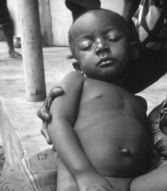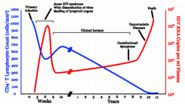|
The history of AIDS (Acquired Immunodeficiency Syndrome), with timelines, photos, and links to resources on the Internet. Endeavoring to raise public awareness through understanding.
|
|
<< History of AIDS last
page || History of AIDS next page >> 1991: Magic Johnson -- Too Good to be True? To be infected with HIV is to be HIV-positive, but only when the virus seriously damages the immune system, does one have AIDS. This distinction has been brought home by NBA star Magic Johnson, who tested HIV-positive and retired from LA Laker basketball in 1991, but has yet to develop AIDS. This may confuse some that his AIDS has been cured,
1993: Thinking Outside the Box? Invariably, someone will suggest a conspiracy about the origin of AIDS, and as Jerry Fletcher (Mel Gibson) said to Alice Sutton (Julia Roberts), "A good conspiracy is an unprovable one." Source: "Conspiracy Theory" (1997) A medical doctor and gay historian, Alan Cantwell, Jr., wrote a book, Queer Blood: The Secret AIDS Genocide Plot, published in 1993, that detailed a genocidal plot by "them" against gays and blacks. Though many younger gays and People With Aids (PWAs) have a greater necessity in coping with today than attempting to understand a theoretical explanation of the now distant past, conspiratorial theorist Cantwell attempted to construct what he saw as a plausible chain of events that would evoke understanding and empathy for the gay community, much as understanding the Holocaust would promote greater compassion and receptivity for the Jewish community. A brief review of Dr. Cantwell's book was given by H. Robert Malinowsky (B.S. geological engineering, M.L.S.), Professor and Principal Bibliographer and Head of Reference at the University of Illinois at Chicago: "There has long been the story that there is a secret gay genocide with the culprit being a genetically engineered virus. Dr. Cantwell was a disbliever in this idea for quite sometime until he started noticing similarities of certain events, when they happened, and how they happened. Although there is no concrete scientific evidence that such a genocide is taking place, there are many questions that have not been answered. Why is it that the AIDS epidemic began at the same time as the hepatitis B vaccine trials in the late 1970s and early 1980s? Why did the African AIDS epidemic begin at the same time as the WHO smallpox eradication vaccine program during the 1970s? The blood specimens of the 1,083 men in the original hepatitis B experiment, as well as the blood of over 10,000 gays screened at that time, it was found that the virus was introduced into the gay community around 1978, the same year that the hepatitis B experiment began. Where did the rumor originate that AIDS is a manufactured virus genetically created to kill off the black race? The unproven belief is that vaccines containing lethal biological agents were injected into the African Blacks and white gays of Manhattan in order to produce a holocaust that would remove two undesirable groups from the earth. Dr. Cantwell goes on to show other similarities and point out other facts that make one wonder if this theory could really be true. One thing that is true is that it is highly unlikely that a Black heterosexual epidemic in Africa could have transformed itself into a white gay disease in America. AIDS first appeared exclusively in young, white, healthy gay men in America. This is a book to be read with an open mind, remembering that there are few concrete facts that support this idea. Nevertheless this is a book and idea to be reckoned with. It is easy to read and takes little time to finish but when finished, you really do not know what to believe, especially if you are a gay male in the midst of the holocaust." Source: AIDS Book Review Journal
The History of AIDS © 2005 |

